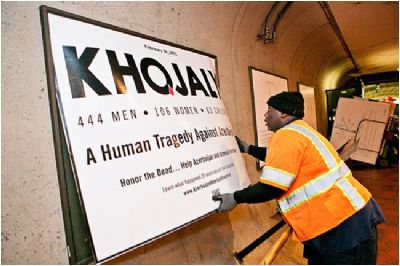March has always made me think of Shakespeare’s Julius Caesar. The soothsayer’s warning, “Beware the ides of March,” is undoubtedly one of the most unsettling and memorable lines of the play. A perhaps more well-known line is the widely quoted “Et tu, Brute?” and the valiant ensuing utterance, “Then fall, Caesar!” Shakespeare, as he is wont to do, captures the drama of this moment so masterfully.
But what if it never happened? It is possible and even likely, considering that Caesar was stabbed 23 times, that he remained silent. Plutarch claims this was the case. So why does Shakespeare’s embellished version seem to speak to us so much more authoritatively? And what does any of this have to do with my work at the ANCA?
An “Armenian genocide” query on a popular search engine yields the expected results, for the most part. There are also some unexpected results that were not there a couple of years ago. On the side of the page appear sponsored ads urging its target audience to “remember Khojaly” and take action.
There is an art to information dissemination. It’s foolish to think that something is more enduring simply because it’s true. Any quick scan over the magazine rack in a grocery store checkout lane will confirm the human bias for spectacle, fanfare, and drama. Of course, repetition is also an important factor. If a story is told enough, as is the case with Shakespeare’s reworking of history, it becomes a part of our collective story.
 Delivery is everything, and spectacle and ubiquity seem to be the most useful components. Our story, while factual, has lacked the fanfare and trumpet blasts required to make it well-known, whereas the Khojaly story, with embedded inaccuracies, is proliferating due to an adherence to these two tenets. A full-page ad in the New York Times is a spectacle, whereas all of the minute advertisements that we don’t consciously acknowledge begin laying a foundation for ubiquity. While the ads quietly nestle themselves into the folds of the internet, most people won’t actively notice them, and they will simply become part of the ad landscape. Many will see it, like any other ad, and won’t pay attention to it. It may come to mind later and, with a healthy dose of cryptomnesia, they won’t recall the source at all and will simply take it as fact.
Delivery is everything, and spectacle and ubiquity seem to be the most useful components. Our story, while factual, has lacked the fanfare and trumpet blasts required to make it well-known, whereas the Khojaly story, with embedded inaccuracies, is proliferating due to an adherence to these two tenets. A full-page ad in the New York Times is a spectacle, whereas all of the minute advertisements that we don’t consciously acknowledge begin laying a foundation for ubiquity. While the ads quietly nestle themselves into the folds of the internet, most people won’t actively notice them, and they will simply become part of the ad landscape. Many will see it, like any other ad, and won’t pay attention to it. It may come to mind later and, with a healthy dose of cryptomnesia, they won’t recall the source at all and will simply take it as fact.
For a more telling example, take the “Kony 2012” campaign. Reaching over 85 million views, Jason Russell tells us outright that his means involve spectacle and ubiquity. And brilliantly, in this campaign, the spectacle (a melodramatic pseudo-documentary) feeds the ubiquity (the video going viral), which in turn feeds the spectacle (playing on the desire to “be a part of something” and plaster signs all over the city), which, subsequently, feeds the ubiquity again (observing the signs all over the city). This video is obviously less about a sudden humanitarian awakening, and more about a man feeding our insatiable narcissism and need for stimulation—the idea that something’s happening and only we can fix it. But it’s brilliant.
 Where does that leave us in all of this? Our story, reaching its hundred year mark, is nearing its expiration date. Time has taught us that something isn’t real just because it’s true. We must, to borrow another quote, become “masters of our fates” by perhaps altering our message and definitely our medium.
Where does that leave us in all of this? Our story, reaching its hundred year mark, is nearing its expiration date. Time has taught us that something isn’t real just because it’s true. We must, to borrow another quote, become “masters of our fates” by perhaps altering our message and definitely our medium.